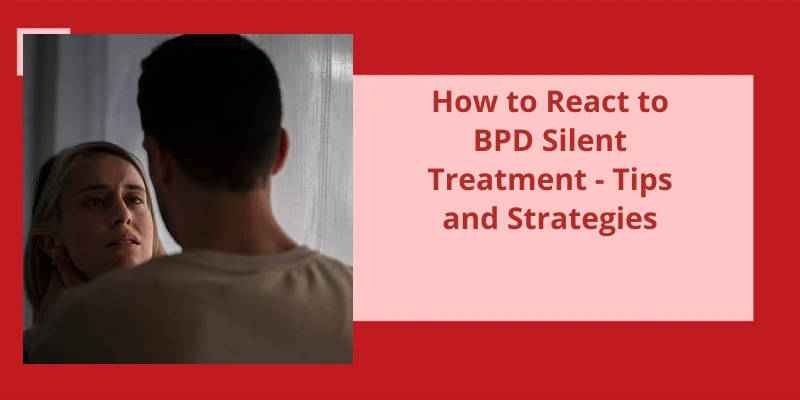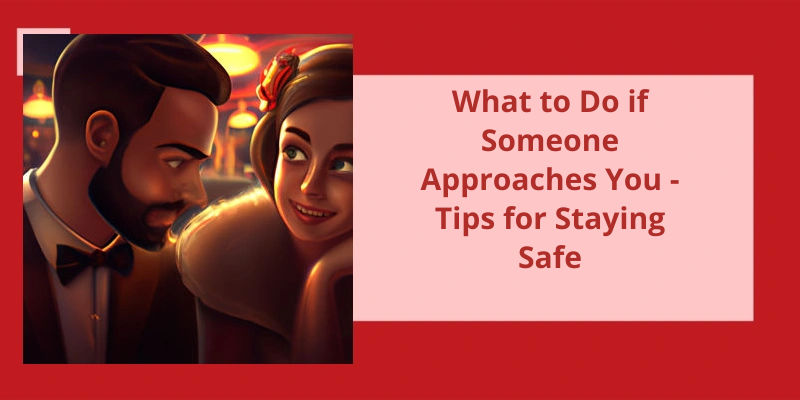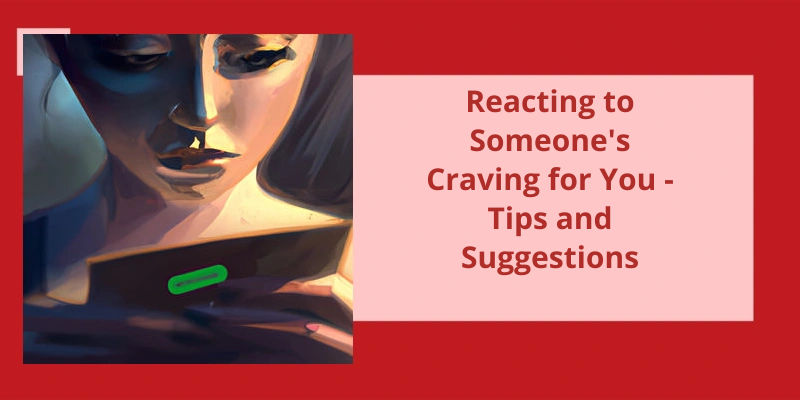In interpersonal relationships, navigating through moments of conflict and communication breakdowns can be challenging. One such challenging behavior that individuals may encounter is the silent treatment, a method of communication avoidance often associated with Borderline Personality Disorder (BPD). When faced with this situation, it’s important to approach it with empathy, understanding, and a willingness to resolve the underlying issues. Rather than reacting impulsively or with anger, it’s essential to remain calm, collect your thoughts, and address the situation with the individual involved. Begin by acknowledging their silence and expressing your desire to understand why they’re choosing not to respond. Highlight your genuine intention to resolve any lingering issues and communicate effectively. It’s crucial to remember that, although you aren’t responsible for someone else's decision to give you the silent treatment, taking responsibility for your actions and offering an apology if necessary can help ease tensions and facilitate a healthier path forward. By approaching the situation with empathy and a commitment to resolving conflicts, you increase the likelihood of promoting understanding, strengthening the relationship, and creating a safe space for open communication.
What Does It Mean When Someone With BPD Goes Silent?
When someone with Borderline Personality Disorder (BPD) goes silent, it can be a sign of their internal struggle. Unlike individuals who may exhibit frequent anger outbursts as a characteristic of BPD, those with Quiet BPD tend to internalize their emotions and suffer silently.
Quiet BPD is often misunderstood because individuals with this subtype may appear calm and high functioning on the surface. They may not display the stereotypical explosive behaviors associated with BPD. Instead, they implode and collapse from within, experiencing intense emotional turmoil that isn’t always visible to others.
Reacting to someone with BPDs silent treatment requires empathy and understanding. It’s essential to remember that their silence isn’t personal and that they may be struggling with their own intense emotions internally. Instead of reacting defensively or becoming frustrated, it’s advisable to create a safe and non-judgmental space for this person to express themselves when they’re ready.
By acknowledging their struggles and offering a non-judgmental space for communication, you can help individuals with Quiet BPD feel understood and supported in their journey towards healing and recovery.
Recognizing the Signs and Symptoms of Quiet BPD
Recognizing the signs and symptoms of Quiet BPD can be challenging, as individuals with this condition often cope with intense emotional pain internally, without displaying visible outward behaviors. However, there are some common signs to watch for:
1. Intense fear of abandonment: People with Quiet BPD may have an intense fear of being abandoned or rejected by their loved ones, even over minor triggers.
2. Chronic feelings of emptiness: They may frequently experience a deep sense of emptiness, which can be difficult to explain or understand.
3. Emotional instability: Individuals with Quiet BPD may undergo frequent mood swings and shifts in emotions, often experiencing intense highs and lows.
4. Difficulty expressing emotions: They may struggle to express or communicate their emotions effectively, keeping their pain and turmoil hidden from others.
5. Self-destructive behaviors: Quiet BPD can lead to engaging in self-destructive behaviors such as self-harm, substance abuse, or risky sexual activities.
6. Relationship difficulties: People with Quiet BPD may have difficulties maintaining stable, healthy relationships due to their fear of abandonment and emotional volatility.
7. Self-isolation: They may withdraw from social interactions and isolate themselves to avoid potential rejection or judgment from others.
Quiet BPD can have a profound impact on individuals’ lives, but with the right support and treatment, individuals with BPD can learn to manage their symptoms and lead fulfilling lives.
Rather than engaging in open communication and resolving the issue, choosing to give them the silent treatment would only escalate the situation and prolong the tension. It’s important to recognize that the silent treatment isn’t a healthy or effective way of resolving conflicts, as it creates a hostile environment and prevents any form of reconciliation. Instead, adopting more mature and constructive methods of communication can help foster understanding and strengthen relationships.
Is Silent Treatment Immature?
Instead of having an open and honest conversation about their feelings, they choose to give you the silent treatment. This childish behavior isn’t conducive to healthy communication and can further escalate the issue at hand.
Silent treatment is a form of emotional manipulation, where the person using it believes that their silence will exert control over the situation or the individual targeted. It can leave the recipient feeling confused, anxious, and even questioning their own actions. This immature tactic tends to breed resentment and can damage relationships in the long run.
When faced with the silent treatment, it’s important to evaluate the situation and consider the possible reasons behind it. Is the person using this tactic struggling with their own emotions and unable to express them in a mature manner? Are they avoiding confrontation or trying to gain attention? Understanding the underlying motives can help inform your response.
Rather than reacting impulsively or reciprocating with silence, it’s essential to approach the situation with empathy and patience. Keep in mind that engaging in a heated argument or attempting to force the individual to break their silence will likely be counterproductive. Instead, give them some space and time to calm down.
Communication is key in any relationship, and addressing the issue once both parties have had a chance to cool down is crucial. Choose a calm and non-confrontational approach, expressing your concerns and emotions in a respectful manner. Encourage open dialogue and encourage the other person to share their perspective, allowing for a deeper understanding and potential resolution.
In summary, while the silent treatment may seem like an easy escape during times of conflict, it’s an immature and ineffective way of dealing with issues. Reacting to it with patience, empathy, and open communication can help diffuse tension and foster healthier relationships. Remember, addressing conflicts in a mature manner is essential for the growth and longevity of any relationship.
Rejection sensitivity can have a significant impact on individuals with Borderline Personality Disorder (BPD), triggering a range of defensive responses. This perpetual fear of rejection often leads BPD individuals to resort to protective behaviors like withdrawal, confrontation, or even sabotaging relationships.
How Do BPD React to Rejection?
Rejection is a challenging experience for everyone, but for individuals with Borderline Personality Disorder (BPD), it can trigger intense emotional reactions. The fear of rejection is deeply ingrained in their minds, and any hint of rejection can be overwhelmingly distressing. This fear often stems from a heightened sensitivity to signals from others, making them hyper-vigilant and constantly on the lookout for signs of rejection.
Some may withdraw completely, isolating themselves from others as a protective measure. They may fear that if they stay connected, they’ll face further rejection or abandonment. Others may confront the person who rejected them, seeking validation or reassurance. This confrontation can stem from a desperate attempt to salvage the relationship and alleviate the intense emotional pain they’re experiencing.
In addition to withdrawal and confrontation, individuals with BPD may also engage in self-sabotaging behaviors as a response to rejection. They may believe that if they destroy the relationship themselves, it will hurt less than being rejected by the other person. These behaviors can include pushing the other person away, engaging in impulsive actions, or sabotaging their own success in an attempt to gain control over the rejection.
The constant anticipation of rejection and the intense emotional reactions it triggers can place a significant strain on their interpersonal relationships and overall well-being.
These impulsive efforts to cope with intense emotions not only strain relationships but can also lead to a self-fulfilling prophecy of abandonment. The person with borderline personality disorder unintentionally pushes people away through their patterns of splitting, amplifying the emotional turbulence experienced by both parties involved. Understanding the mechanisms behind these actions can shed light on the challenges faced by individuals with BPD and help cultivate empathy and support.
How Do BPD Push People Away?
Borderline Personality Disorder (BPD) is a complex mental health condition characterized by intense emotions, unstable relationships, and impulsive behaviors. One common way individuals with BPD push people away is through a defense mechanism called splitting. Splitting occurs when someone with BPD views others and situations in extremes, either as all good or all bad. This black-and-white thinking can lead to impulsive reactions that ultimately push their loved ones away.
When a person with BPD experiences overwhelming feelings or perceives a threat to their emotions, they may react impulsively to get rid of these intense emotions. This can manifest as sending abusive messages, engaging in reckless behavior, or abruptly ending relationships in the heat of the moment. The individual may feel an immediate sense of relief after such actions, as they believe they’ve rid themselves of the perceived threat. However, these impulsive behaviors often have long-term negative consequences and can deeply affect their relationships.
Frequent splitting behaviors can significantly strain relationships as the person with BPD may struggle to maintain a stable and consistent connection with their loved ones. Friends, family members, and partners may feel constantly on guard, unsure of how their loved one will react in any given moment. This unpredictability can create a sense of fear and distance, ultimately pushing them away.
Furthermore, the intense emotions experienced by someone with BPD can be overwhelming for their loved ones. The constant ups and downs, accompanied by episodes of anger, fear, and sadness, can take a toll on the emotional well-being of those close to them. As a result, the partner or friend may feel exhausted and helpless, leading them to distance themselves in an attempt to protect their own mental health.
Understanding and empathy are important when reacting to BPD silent treatment. Recognizing that these behaviors stem from the persons inner struggle and not from deliberate malice is crucial. Communication and therapy can provide constructive ways to address the challenges faced by individuals with BPD. Encouraging them to seek professional help and offering support can contribute to a healthier and more stable relationship. By fostering an environment of open communication and building trust, it’s possible to navigate the difficulties that arise from BPD and maintain a strong and supportive connection.
The Impact of BPD on Friendships and Social Relationships
- Difficulty maintaining long-term friendships due to the intense and unstable nature of interpersonal relationships
- Frequent arguments and conflicts with friends caused by the person with BPD’s emotional instability and fear of abandonment
- Avoidance of social situations or isolation, as individuals with BPD may struggle with feelings of low self-worth or fear of rejection
- Tendency to idealize or devalue friends, leading to fluctuating levels of closeness and trust
- Manipulative behaviors and extreme reactions to perceived slights or rejections, which can strain friendships
- Difficulty regulating emotions and managing impulsivity, leading to impulsive, reckless, or harmful behaviors that may adversely affect relationships
- Fear of abandonment and a constant need for reassurance, which can be overwhelming for friends
- High sensitivity to perceived criticism or rejection, which can result in overreacting or assuming negative intentions behind others’ actions
- Tendency to rely heavily on friends for emotional support, which can lead to emotional exhaustion and strain on the friendship
- Likelihood of engaging in self-destructive behaviors or self-sabotage, which can negatively impact friendships
Conclusion
Rather than resorting to assumptions or confrontations, calmly express your concern for the disconnect and your genuine desire to comprehend the underlying reasons. Prioritizing resolution and fostering open communication, irrespective of fault, can pave the way for healthier interactions and potentially mend strained relationships.






